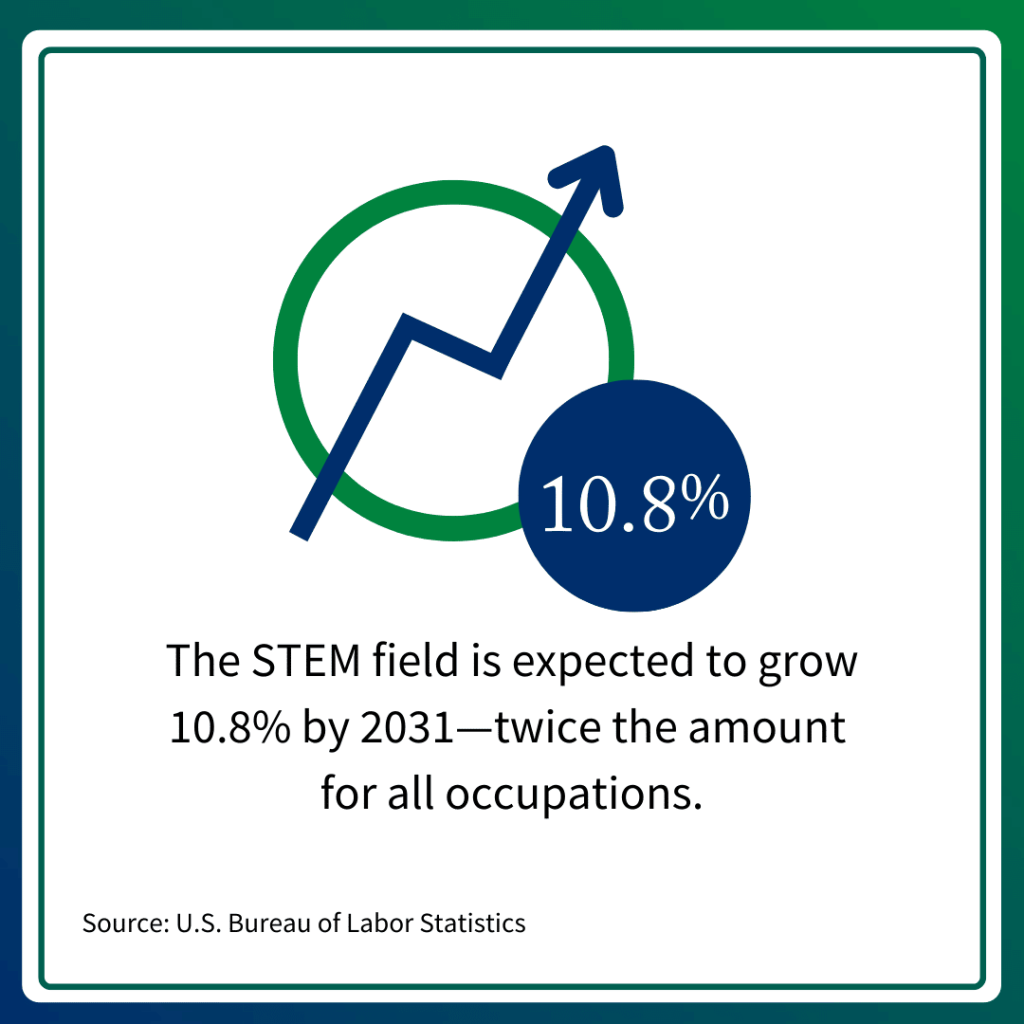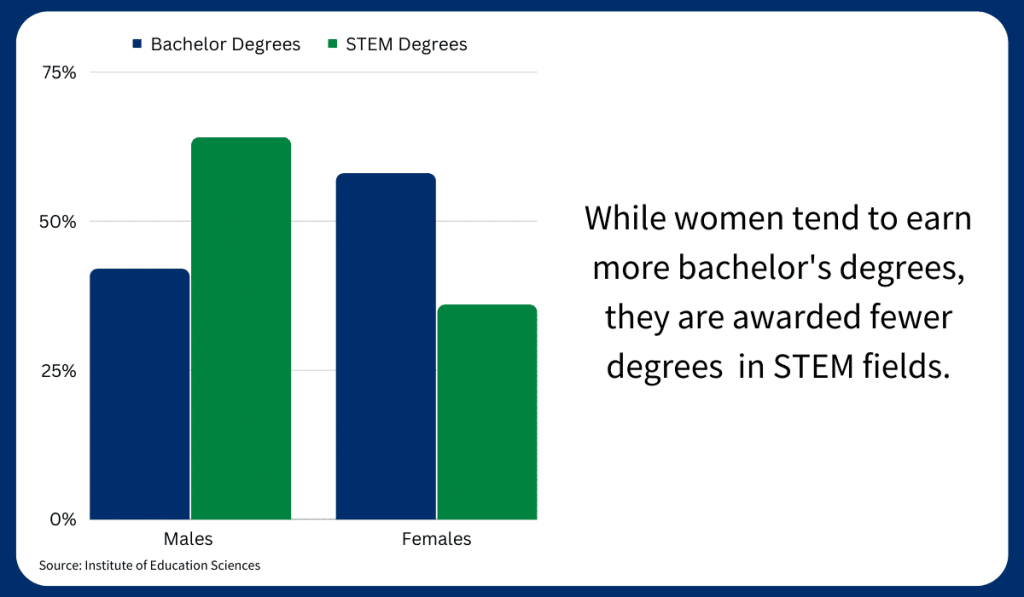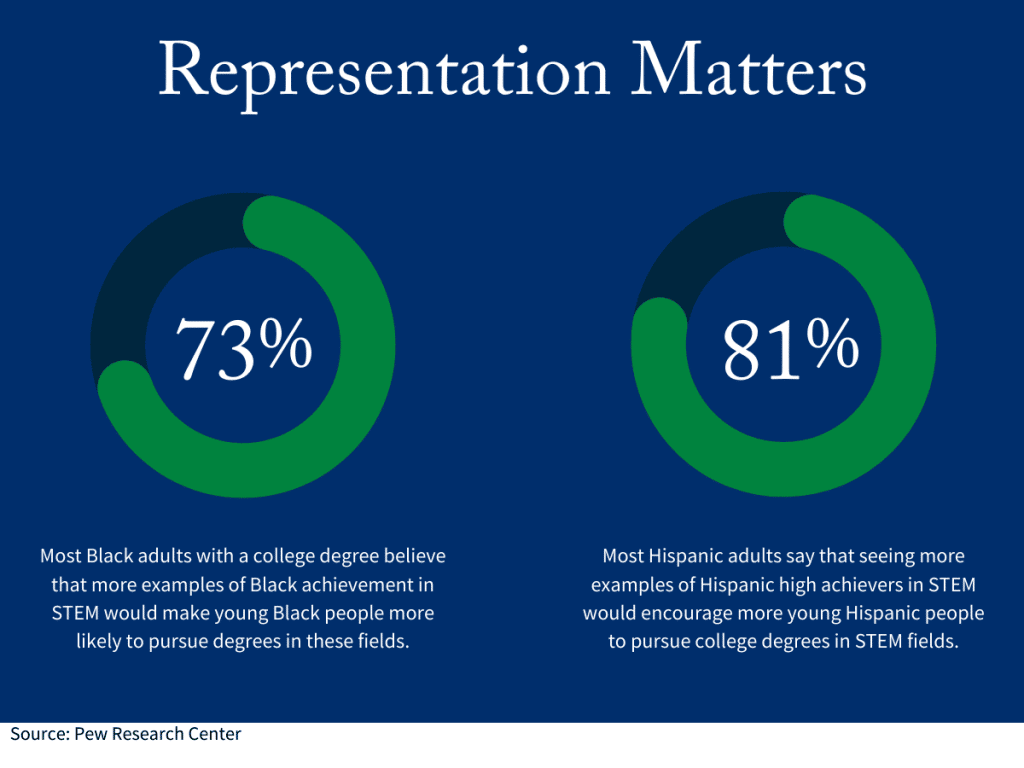
Creating Opportunities for Diversity in STEM
You’ve probably heard of STEM before. It’s advertised as the high-earning route for job security. It’s exciting, constantly evolving, and a degree in a STEM field opens doors to opportunities in various industries. Discover statistics about minorities in STEM and what you can do to encourage more diversity in STEM.
The development of technology in recent years caused a push for more technical training in STEM fields. STEM fields are expected to grow 10.8% by 2031 compared with 5.3% for all occupations.1
What is STEM?
STEM stands for Science, Technology, Engineering, and Math—though many of these areas overlap in occupations. UX/UI research, software engineering and AI development are all emerging disciplines requiring more than one STEM subject.
STEM programs focus on building the technical skills needed to fill labor force gaps necessary to drive innovation. Students of these programs learn skills like coding languages, advanced mathematics and data analysis.

Diversity in STEM—Underrepresented Minorities
You know that STEM is essential to the development of society, but why are minorities underrepresented? It’s a continuing cycle. The lack of diversity in STEM is caused by a lack of representation and opportunities in these technical fields. This statement is true for women and racial or ethnic minorities like Black and Hispanic professionals.
To best understand issues of diversity in STEM, you must examine the educational system. “The long-term outlook for diversity in the STEM workforce is closely tied to representation in the STEM educational system, particularly across the nation’s colleges and universities,” said Fry, Kennedy and Funk.2
Women in STEM
As of 2019, nearly 75% of the STEM workforce is male.3 A 2022 study found no “statistically significant difference in overall interest in STEM between male and female students.”4 Now, you might wonder, “if women are interested in STEM subjects, why are there not as many women in STEM?”
1 in 3 girls change their mind about pursuing STEM in higher education at 15.5 Before female students graduate high school, many have decided not to pursue a highly technical education.
Research supports the idea of a gender confidence gap between males and females. Female students expressed concern about the following:
- Not being qualified for STEM jobs,
- STEM careers being too competitive/stressful, and
- Not having the right connections to succeed in the field.6
Factors like gender stereotypes held by parents and teachers, lower levels of STEM confidence, and doubts about STEM competence among girls prevent women from continuing to pursue STEM majors in college.7

Women need support and encouragement through role models in the industry, yet women are still an underrepresented minority. In 2021, the U.S. Census found that the population of women in STEM fields has grown. In 2019, 27% of STEM workers were women compared to 8% in 1970.8
Supporting the education of female students in STEM subjects is imperative to the success of a nation. Technological development and innovation need to be developed and sustained, but there aren’t enough workers.
Two alumnae of Regent University pursuing a B.S. in Mathematics had the opportunity to contribute to active research in mathematics. Abigail Lindner completed a journal article about agriculture in sub-Saharan Africa and its impact on the economy and human development. Allison Hodgkins helped create a mathematical model of the Guinea Worm Disease that reoccurred in Chad.
Schools and universities celebrating women’s success in STEM are critical to growing the female STEM professional population.
Black and Hispanic Students in STEM
A study conducted by the Pew Research Center shows Black and Hispanic populations are underrepresented in STEM fields.9 Some of these populations experience fewer opportunities to explore STEM in school or interact with those in a STEM field. However, this doesn’t stop racial and ethnic minorities from being interested in STEM.
Black and Hispanic students enroll in STEM college programs at the same rates as other students but are less likely to complete a STEM degree.10 These students face difficulties finding the community and support they need from their schools.
Past studies have considered reasons for underrepresentation, including:
- lack of racially and ethnically diverse mentors,
- limited access to advanced science courses,
- or other socioeconomic factors that could disproportionally affect these communities.11
Like women, racial and ethnic minorities are missing the role models their peers have in STEM education and professions. Many Black and Hispanic adults say that having more examples of high-achieving minorities in STEM would encourage more students to pursue a STEM career.12

Anicca Harriot, an alumna of Regent University’s B.S. in Biophysical Sciences program, is passionate about increasing minority representation in STEM. In 2016, she calculated the angle of a dab, a dance move made famous by Carolina Panthers quarterback Cam Newton and other athletes. Her tweet about her calculations went viral affording her the opportunity to participate in a STEM panel with the White House Initiative on Excellence in Education for African Americans.
Now, Anicca is the Chief of Community Development for Vanguard STEM, an online platform and community that discusses the experiences of people of color in STEM. The contributions of students like Anicca are felt by minority communities where the visibility and accessibility of people of color in STEM make all the difference.
The Importance of Diversity in STEM
Increased diversity in STEM lessens economic gaps between racial, ethnic and gender minorities. However, increasing STEM diversity has more than just economic benefits.
STEM is one of the foundational elements for innovation and discovery. Diversity in technical fields helps people study things from new perspectives. Each person brings their experiences, questions and understanding of the world together, resulting in discoveries and better results.
A diverse team of problem solvers is more likely to outperform a less diverse one, even if the less varied team has individually high-performing members.13 Diversity facilitates problem-solving and increases the improvement of current processes.
How Can You Contribute to STEM Diversity
Diversity in STEM is an issue that you can help address regardless of your identification.
Speak Up Against Discrimination in Your Class or Workplace
Social psychologists have studied the bystander effect and found that individuals are less likely to intervene when they know others could do so. When the bystander effect occurs, no one does anything because they don’t feel a strong responsibility.
A 2018 study found 62% of Black STEM professionals and 42% of Hispanic professionals report experiencing workplace discrimination.14 The same study found that “nearly half (48%) of female STEM workers in majority-male workplaces say that sexual harassment is a problem where they work.”15
Don’t be one of the bystanders. Speak up when you find something to be discriminatory against minorities. They need you to advocate for them in spaces that might not have a place to express their concerns.
Build Community with Minorities in STEM
Despite how it may feel, thousands of other minority students and professionals face similar problems every day. Seek out opportunities in your school or workplace to connect with others who will offer support through your STEM journey.
Celebrate the Wins of Minorities in STEM
Minorities have expressed that not seeing enough high-achieving representatives in STEM makes it challenging to envision goals and opportunities for success. Celebrating the achievements of minorities in STEM will help bolster the interest of these communities in STEM programs and professions.
Trailblazing for STEM Diversity
Don’t give up if you are a student interested in STEM or currently enrolled in a STEM program! You could discover the next groundbreaking math model. You could create a new way to use artificial intelligence to help people get the healthcare they need.

“If you don’t see anyone who looks like you, then that’s the very reason you do belong—because your perspectives and ideas are unique. You’d be surprised how many people (especially in STEM) have begun to recognize the need for diversity. You are not only needed, but you are wanted.”
Eliya Pelton, B.S. in Computer Engineering ’24
STEM needs you. The next generation needs you.
Attending a university that supports your goals and genuinely wants to help you succeed is imperative. Consider:
- Resources available through your university, like STEM programs or research opportunities
- Quality of the STEM programs offered
- What opportunities are available to connect with other minority students pursuing STEM degrees
All students at Regent University have access to resources, including financial aid and scholarships, academic coaching, and caring faculty. You’ll also find environments created to lend to professional success in STEM, like the state-of-the-art Cyber Range that is accessible for online and on-campus students. Regent’s STEM degrees are top-ranked and transfer into real-world contexts. Get ready to change the world.
If you’re ready to build your legacy, request information or call 757.352.4000.
References
- U.S. Bureau of Labor Statistics. (2022). Employment in STEM occupations.
- Fry, R., Kennedy, B., Funk, C. (2021, April 1). STEM jobs see uneven progress in increasing gender, racial and ethnic diversity. Pew Research Center.
- Martinez, A., & Christnacht, C. (2021, January 26). Women are nearly half of the U.S. workforce but only 27% of STEM workers. U.S. Census Bureau.
- May, B. K., Wendt, J. L., & Barthlow, M. J. (2022). A comparison of students’ interest in STEM across science standard types. Social Sciences & Humanities Open, 6(1), 100287.
- Ipsos Public Affairs. (2021). The STEM gender gap: perceptions of girls towards STEM fields and careers. Corteva agriscience.
- Ibid.
- Tang, E., Katz, A., Morris, L., Lieberman, A., Mutual, C., Klein, S., Washick, B., Cochran, C., Johnson, A., Kristen, E., Becker, J., Lufkin, M., & Rincon, R. (2022). Title IX at 50. National Coalition for Women and Girls in Education.
- Martinez, A., & Christnacht, C. Women are nearly half of the U.S. workforce but only 27% of STEM workers.
- Fry, R., Kennedy, B., Funk, C. STEM jobs see uneven progress in increasing gender, racial and ethnic diversity.
- Riegle-Crumb, C., B. King, and Y. Irizarry (2019). Does stem stand out? Examining racial/ethnic gaps in persistence across postsecondary fields. Educational Researcher 48(3), 133–144.
- Funk, C., Parker, K. (2018). Blacks in STEM jobs are especially concerned about diversity and discrimination in the workplace. Pew Research Center.
- Funk, C. (2022). Black Americans views of and engagement with science. Pew Research Center.; Funk, C., & Lopez, M.H. (2022). Hispanic Americans’ trust in and engagement with science. Pew Research Center.
- Hong, L., Page, S. E. (2004). Groups of diverse problem solvers can outperform groups of high-ability problem solvers. Proceedings of the National Academy of Sciences, 101 (46), 16385-16389.
- Funk, C. & Parker, K. (2018, January 9). Women and men in STEM often at odds over workplace equity. Pew Research Center.
- Ibid.

